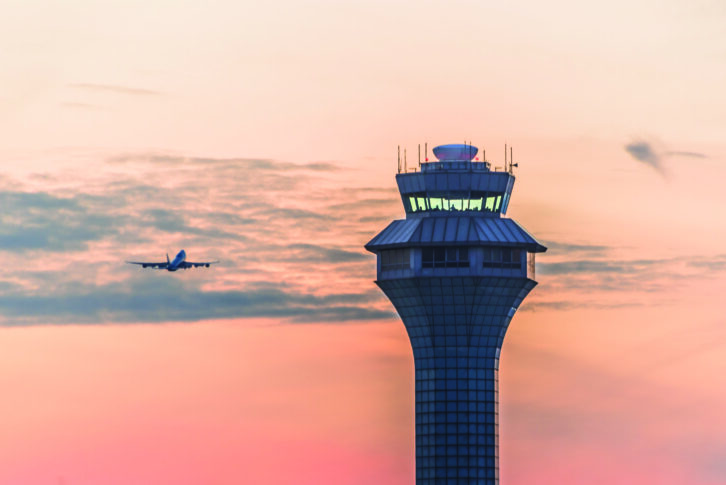
Supporters of a proposal to allow more FM HD Radio stations to raise digital power and use asymmetric sidebands are hoping that an exception for 107.9 MHz will allay concerns in the aviation industry.
Xperi, the developer of HD Radio, and the National Association of Broadcasters had asked the FCC to allow more stations to increase digital power over the currently authorized digital ERP of –14 dBc, without separate authorization. The goal is to improve digital FM coverage in mobile environments as well as building penetration.
If more stations adopt HD Radio, Xperi and NAB wrote, transmission equipment manufacturers will continue to invest in the development of equipment, reducing costs and expanding the ability of smaller broadcasters to afford the conversion to HD Radio.
Last summer the commission, in a notice of proposed rulemaking, indicated tentative approval of the change and asked for public comment.
But the effort suffered a setback when the Aerospace Industry Association and the Air Line Pilots Association International expressed concern about the possibility of interference between HD Radio stations at 107.9 MHz and the adjacent 108.0–117.975 MHz used by Aeronautical Radio Navigation Services.
The supporters subsequently offered a compromise of sorts, according to people familiar with the issue: Perhaps the changes should be enacted, but FM stations at 107.9 that wish to implement higher power would still need experimental authorizations.
Xperi and NAB are hoping this will provide enough assurance to the FCC to allow stations on the rest of the band to proceed.
More power
The main proposed change is to the methodology for determining a digital FM station’s maximum allowable power. It would permit more stations to increase digital FM power up to –10 dBc, or 10% of analog power, without special authorization.
How to handle so-called superpowered FM stations is also one of the questions being discussed; several commenters mentioned potential use cases and procedures that the FCC could consider in its final rules. Many commenters agreed that such stations seeking to increase digital power may still need to request authorization if they qualify under the new methodology. Some commenters suggested that superpowered FM stations would only qualify if they are properly spaced from first-adjacent facilities.
The NPRM also would allow FM digital stations to operate with asymmetric sideband power levels. The idea was originally pitched by Xperi, NAB and NPR; the FCC subsequently merged it with the first proposal.
There are approximately 2,600 FM radio stations using HD Radio in the U.S., according to Xperi.
Broadcast groups including iHeartMedia, Audacy, Cumulus Media, Educational Media Foundation and NPR have expressed support for many of the proposed changes. REC Networks too has been supportive of many of them and has offered additional ideas of its own for the commission to consider.
Comments on the FCC’s “Modifying Rules for FM Terrestrial Digital Audio Broadcasting Systems” (Docket 22-405) can be reviewed online at the FCC’s website.
Aviation concerns
The Aerospace Industries Association said it had identified several locations where licensed FM stations at the top of the band are near airports with active aviation navigation aids.
The Air Line Pilots Association International represents the safety interests of 75,000 pilots flying for 43 airlines in the United States and Canada. The union told the commission that it worries about potential interference on navigation systems in the Aeronautical Radio Navigation Service band, used for navigation and landing systems essential for safety of flight, such as landing during low-visibility conditions at night and during inclement weather.
“Interference from FM digital broadcasting at the upper end of the 88–108 MHz band that affects the operations of these aviation systems would present a significant safety hazard and would disrupt aviation operations by delaying, diverting and canceling potentially hundreds or thousands of flights,” the pilots union told the FCC.
ALPA asked the commission to work with the National Telecommunications and Information Administration and Federal Aviation Administration to analyze the risk to aviation. It asked the FCC to consider limitations on the upper part of the FM band and in the use of digital upper sideband and total power of stations at 107.9 MHz.
A pause at 107.9?
NAB told the FCC that it was not aware of any reports of interference to navigational aid receivers from FM digital radio transmissions since stations began operating digital facilities. But Xperi and NAB said broadcasters take these issues seriously and were engaged in “constructive dialogue” with aviation and aerospace stakeholders.
NAB and Xperi last fall asked the FCC to consider moving ahead while creating special rules or a temporary pause for stations that operate at 107.9 MHz while avionics interference investigations are performed.
“To further ensure that aeronautical radionavigation services are protected from potential interference, the commenters submit that digital FM radio stations operating on 107.9 MHz could be required to request experimental authorization from the commission when seeking to increase power levels pursuant to the updated power level formula proposed in the NPRM,” Xperi and NAB wrote.
The aviation groups say further testing is needed to assure that power increases for FM stations on 107.9 would not interfere with nearby instrument approaches on runways using a 108.1 localizer frequency. NAB and Xperi told the commission they support such testing; and NAB told the FCC it would report back on any concrete results arising from test efforts. Such testing involving the radio and aviation industries could take several months, NAB said.
Meanwhile Xperi and NAB say the public interest would not be served by delaying the change for stations on the other 99 designated FM channels from 88.1 to 107.7 MHz.
“This approach will bring the benefits of enhanced service under the proposed power formula to as many listeners as possible as rapidly as possible,” they wrote.
Apparent caution
Some observers told Radio World that the FCC is probably proceeding cautiously given public reaction to a separate story that made headlines in 2021.
The aviation industry at that time raised concerns that new 5G wireless signals potentially could interfere with airplane altimeters, leading to disruptions at some U.S. airports.
Subsequent studies concluded that 5G signals did not interfere with avionics. The FAA and FCC eventually came to an agreement that 5G signals in the C-band were not interrupting aeronautical navigational devices. However, the public infighting between the wireless carriers and aviation industry garnered a lot of media attention.
“The aviation and FAA folks are very nervous about any new RF service since the debacle with the 5G airport issues,” one source told Radio World in an email. “Now any new service or new application is getting a new level of scrutiny.”
One broadcast engineering source pointed out that FM IBOC has been authorized since 2002 and said the aviation sector had missed opportunities to comment in the three prior NPRMs that led to the 2002, 2007 and 2010 IBOC orders.
“FM IBOC has been authorized and in use for 22 years,” this person said. “Elevated IBOC operations at –10 dBc have been authorized and in use for 14 years. Certainly let’s examine the issue. Everyone agrees safety is important. But it is also important to note that FM IBOC and the aviation industry have coexisted peacefully for nearly a quarter of a century.”







